Descending into the Aniakchak caldera
A spectacular landscape in the dry caldera of the Aniakchak volcano on the Alaska Peninsula. We set out to explore this seldom-visited unit of the National Park Service in 2009. The caldera itself is 6 miles in diameter with a diverse array of geologic features including streams that emerge from lava tubes, several cones from past volcanic activity, fields of lava, warm springs, and a small lake known as Surprise Lake. Surprise Lake is the source of the Aniakchak Wild and Scenic River which flows through a gap in the caldera known as The Gates.
For more of the story check out the write-up of our trip by Harry House for the Outdoor Research Verticulture Blog:
The Gates of Paradise, July 2009
Harry House
Megi, Tom, and I stood on the grey ash and rock rim of the volcano, looking down into the mist. As we waited, we dropped our overloaded packs into the wet dust at our feet. The same wind that was chilling our sweat was also whipping the fog into eddies in the chasm below. Swirling. Spinning. Slowly lifting; higher and higher. Watching.
And then, we saw it.
Down in front, a perfectly circular vent of sand-like ash hundreds of feet high. A child’s dream playscape, for Tonka Trucks, pails and shovels, or simply rolling their bodies in. Looking a bit higher, the entire caldera revealed itself. Snowfields. Lava fields frozen in motion; slick black or covered with moss. Undulating. Sliced with meltwater rivlets and gulleys. Stretching beyond, six miles, a horizontal sliver of blue against the other rim – the lake. The entrance to the Gates. And just like that, it was gone. But we had seen enough… a memory snapshot.
We knew we had a clear descent to the floor of the crater. A thousand foot plunge through a repose of course black sand. Energized, we shouldered our packs, and descended into the haze. Against our instincts, slowly, carefully, respecting the weight on our backs pressing down with each step into the slanted ramp. By the time the slope leveled off onto the flats, our thighs were burning. No matter. We had entered a new world; a self-centered ecosystem that played by its own rules, permitted to do so by surrounding walls thousands of feet high in all directions. Though we had miles to go before our lake camp that evening, we all felt a sense of exhilaration and attainment. For the next few days, this would be our playground to explore. We felt free, like ‘adventurers’, if there is such a thing anymore. In the sequence of our plans, we had just completed a ‘crux move.’ Our visions were all forward looking; to the caldera, the Gates, and the rivers beyond. If we had taken a moment to reflect, we would have realized we were also potentially trapped.
For the next two days, we climbed lookouts, bathed in hot springs, and paddled the lake. An immense brown bear ambled by our camp the first evening, heading across the flats until the low white cloud engulfed him. If he hit the wall on the other side, would he bounce back into us?
One morning, I walked alone to the outlet of the lake, where the river formed and made its way to the singular cut in the side of the bowl; the Gates. I came to the point where it made its break through the gap; a low flat terrace covered with colored lupine, with the river sliding quietly past to my left. Downstream, the river boiled through a set of rock teeth. To my right, a small tributary that sourced from under a lava flow added its weight to the river’s momentum on its way to the Pacific. I stood entranced for a long time. The day after tomorrow, we would begin our descent through the Gates. I had dreamed of this spot, of that moment, for a quarter century. “There’s this volcano; it has a lake in it, and a whitewater stream pours out of it to the ocean: Run the volcano.” That either resonates with someone, or it doesn’t. It can’t be explained. If it does, it’s impossible to be disappointed with the reality once you’re there. What I didn’t expect was how stunning it all was; how perfect the point of egress. For me, it was a misty paradise.
The next morning, before our final hike, I said to Tom and Megi, “I’d like to say that at this point we’re home free, but I know better than to ever say that, so I won’t.” Prophetic. We packed extra gear and food, and set off on our last excursion in our hidden world. Our route took us to the other side of the crater and around a large vent mountain. What we didn’t know was that the largest storm of the summer was approaching the volcano.
It started slowly, building over a period of a couple hours, at our point of maximum distance from camp. By the time we started angling back, it was in full force. An hour from camp, gusts were picking up handfuls of gravel and driving them into our backs. After one particularly heavy blast, I told Tom, “If a gust like that hit our camp, it’s gone.” Tom began to run towards camp across the hardpan flats. He disappeared in the driving rain and fog. As Megi and I neared camp, we could make out Tom waterbugging about the area, and then sprint downwind across the tarmac. I knew at that moment we had problems.
When we arrived in ‘camp’, it became immediately obvious how serious the situation was. The shelter had been flattened and was in disrepair; the bivi sacks, sleeping pads, and sleeping bags were gone. All of the clothing was wet, as were we. Megi took off after Tom and disappeared into the mist. We had a little over an hour until dark. I gathered together what was left of the camp, bunched it downwind of a soil berm, and started moving towards the others.
Most of us who recreate in the outdoors never come close to death; not really. Or maybe some of us do, but are too unaware to realize it at the time. How many of us wonder, “If I ever was in such a situation, how would I react? How would my partners react?”
I don’t have to wonder anymore.
As I walked through the storm, I felt almost disembodied from the reality of the situation. While none of us were “professional outdoorsmen/women”, or better yet, natives living in the wild, we certainly had enough experience to fully realize the implications of our predicament. It’s not that we didn’t have good gear. For example, Tom, the gear nut, had suggested we all go with the Outdoor Research Advanced Bivi Sack, which he considered the best of the best. Which was all fine and good, until it goes blowing across the caldera like a drunken weather balloon. I continued to simultaneously act and detachedly observe. It was almost like an academic study; “so this is how people perish in the outdoors...by increments.”
Ahead, I saw Tom hand Megi an armful of gear, but before she could get back to me, she dropped to the ground to keep it from blowing away. There was a lot of scampering and long running, at least by Tom. Some of us did their best to act calm. Others concentrated on persevering. Search for a new camp, away from the Gates. Miraculously, and probably fortuitously, all three bivi sacks were recovered and a few other things. Insulation? What’s that? Darkness fell, and we burrowed into a makeshift nest as time ran out. I remember green parachute cloth between my face and a cold, wet piece of lava; the feeling of chilling, wind-driven rain racing over the tops of our bodies. But mostly, I remember a voice in the dark stating: “Actually, I’m not sure we are ok.”
We later learned winds were clocked on the volcano at 80 mph, but I suspect they were higher near the Gates. No big deal, unless you’ve lost your toys in the rain.
Morning broke, and we spread out looking for gear and trying to improve the situation. We found one parachute chord. Critically, one of the boats was missing. The storm dropped some, but was still running hard. Someone asked me in my experience, how long storms like this last up here, and I said “three days.” (It lasted five.) We examined our options, considered the risks, and made our decision.
We triggered the emergency beacon late that morning, so whoever might come would have plenty of daylight to work with. A couple hours later, a Coast Guard C-130 out of Kodiak began overflying the volcano. Then we heard a Jayhawk helicopter thwupping through the Gates a hundred feet off the deck, cross the lake (lights flashing), and drop down into the wind on a nearby ridge, power on. “That took some balls”, I thought. In minutes, we were barreling down the river and out of the caldera.
Surreal. Grateful. Embarrassed. Stunned.
The captain told us we had left the best contingency plan they’d ever seen. Said it wasn’t our fault (of course it was.) Park Service said the same thing the next day. Nice of them all, but we knew better. A series of small mistakes normally don’t matter, but they do when you’re five miles from camp in a blowout. How lucky to have the U.S. Coast Guard watching your back, at least once.
So what does one do when your dreams are crushed by the winds of fate? You’ve had your memory, and given it your best shot after all. In this modern world, that’s about as good as it gets in any event. At the end of the day, there’s always another mountain to climb; always another river to run, by yourself or someone else. Who really cares what would have happened to us on the other side of the Gates? Who cares if we ever stand again on that terrace of flowers, boat in hand, about to complete a youthful dream? Who cares?
We care.
Run the volcano.
Return to Paradise, July 2010
Harry House
One year later, we stood again on the crater’s rim, looking down into the depths of our emotions.
This time, sunlight played across the entire caldera, revealing formations and undulations we had never seen during our previous encounter. For the first time, we could see the entire majestic panorama before us; like a reward of some sort. “Welcome back”, the wind whispered. Shyly: “Did you miss us?”
“Did we miss the volcano?” I’m not sure any of us had thought of it like that. A strong desire to ‘finish the trip’ took hold within days in each of us the year before. The hard way - again. Stubborn –determined… stupid? But Miss It?
“Yes”, we replied – “we missed you.”
Down the same slope of cinders we plunged, approaching new fields of snowpack glaring back at us in the sun. As we rested at the bottom, seven caribou sashayed past while we snacked. Rising again, we headed across the landscape toward the lake. We knew the way. By evening, we were putting our camp down within two feet of where it was when the storm hit the year before. A stronger camp – tighter, but with escape routes planned, like a wildebeest at a waterhole.
At our feet, still in the ground, stuck a stake from the year before. I used it.
We spent the next three days exploring the caldera floor and features, ‘looking for gear’ as an excuse. The Park Service had found one of our sleeping bags earlier, and we stumbled onto a paddle. Not much else - except for all the geomorphic treasures hidden by space and time. “I’ve never seen something that looked like that before”, I would ponder. “Be careful where you step”, we would say to each other. “It’s bigger than I thought it would be”, I would muse. I felt like we were doing time in nature’s funhouse.
Lest we forget where we were, the volcano soon reverted to form – hitting us with wind and rain, shutting down visibility and preventing any visitors from dropping in on us from above. Outdoor Research had ensured we were prepared for it all – as long as we kept their provisions in-hand. For those days, the funhouse gave access in spurts, but protected us as well, like new friends. “See”, she said, “I can be nice when I want to be.”
As we traversed the landscape, we at times came across our path from the storm. “This is where I got picked up and blown through the air!” Megi exclaimed. “This pond looks different now – I can actually see it!” “Here’s where Tom ran for the gear.”
When we came to the ‘emergency camp’, where we had spent the night in the storm, people became quiet, unsure of what to say or do. We found a few stakes buried in the grass; took a ‘group photo’. We climbed up to the ridge where the Coast Guard had dropped in with the Jayhawk, and stood on the spot where they put down. “Other people will stand here someday,” I thought. “They may camp here, or have a snack. They will take in the view, and maybe remember it for the rest of their lives.” I looked down towards the emergency bivouac, reflecting. “But we will emotionally own this patch of ground until we die.”
It was misty and cold the day we ran the volcano.
As we slipped through the Gates and out of its embrace, the volcano shut down behind us. “Go”, she prodded us, “it’s time for you to go.” And so we did. In heavily loaded Pakrafts, we ran. We ran for closure and redemption, and a promise to the Coast Guard. We ran because we are paddlers, and that’s what we do. We ran for each other. But mostly, we ran for the sheer joy of descending a pristine river that comes out of a volcano in the middle of nowhere.
For miles, the river sped through tundra and spilled over rocks and ledges without pause. I put my foot through the bottom of my raft on a sharp rock. I ran the next drop with it hanging out the bottom like the Flintstones drive a car, up to my hips in water. No matter. Megi and Tom patched the boat, and we continued down to where the river paused the next day.
In our plans, we had hoped to complete a giant circle back to where we began, via a second river to the southwest. With some regret, we collapsed our boats and left the river behind, our last connection to the interior of the volcano. From now on, we ran under the shadow of the volcano as we wrapped around its base, but were no longer part of its hidden secrets.
A day later we found ourselves re-inflating our rafts next to a muddy bank, about to put in what looked like an irrigation ditch next to a lake. Three Red Salmon swirled in the stagnant water at our feet. “You know what that means”, said Tom. “Bears”, I nodded. An hour later, a side stream came in, and the ditch turned into a clear, narrow stream hurriedly winding over gravel bars and high banks. The salmon ran in thick schools from shore to shore. At every turn, we envisioned startling a sow and her cub, fish-in-mouth, not amused. We ‘sang out’ for two days running.
And bears there were; a gauntlet of them; each one behaving in their own manner. Running away, running towards us and standing to look, not running at all, but slinking back into the brush. One, having jumped out of the river at seeing us, thought better of it, jumped back in to grab a particularly nice fish in his mouth, and then hopped back up onto the bank again to watch us slide past while he dined.
The weather worsened as we descended the river towards the Bering Sea. Though we were only a few miles from the volcano, we caught only occasional glimpses of it to remind us where we were. Unsure of the wisdom of taking the rafts all the way out to the ocean and down the coast, we elected to pull off the river a few miles from the mouth and portage back to our starting point. Looking back on it, logistically, that was probably a mistake.
The next two days entailed a lot of swamp-walking, with occasional slivers of relatively hard ground to follow. The packs were still too heavy for conditions, the price we paid for combining a river trip with an extended backpack journey. As a friend told me once, when experiencing the consequences of a questionable course of action in the outdoors, we were “out here to get some EXERCISE!”
Two weeks after we departed, we stood again on our point of embarkation. Our bodies had paid the price. When we got back into town, we asked a helpful fellow we had met the year before if he thought we were going to make it this time. He smiled, dodged the question, and said “we were just discussing yesterday that you were about due back today…”
The next day, we boarded a plane back to Anchorage and homeward, back to our normal lives and routines. Airborne, we looked out the windows to the south, towards the volcano, but it was veiled in angry clouds, as usual. Just as well - to remember it like that. Each of us knew what lay concealed in that curtain of mist, both the physical wonders and our own memories.
We also knew we would likely never return.
Photos on Flickr from our 2009 Trip
Photos on Flickr from our 2010 Trip
Google Earth File of our Campsites

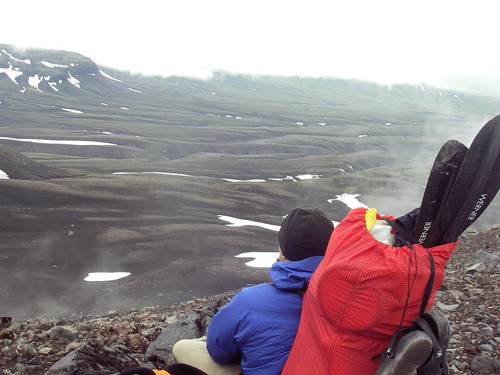
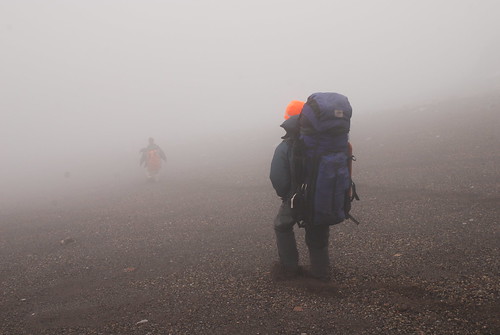


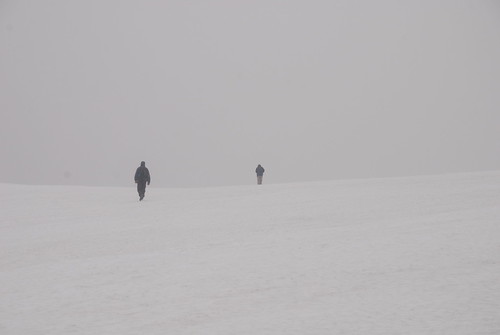
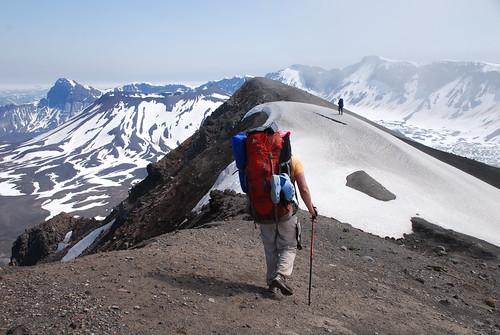
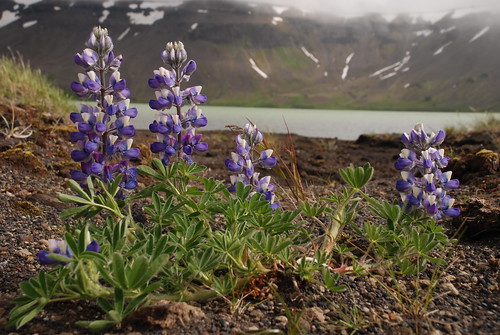
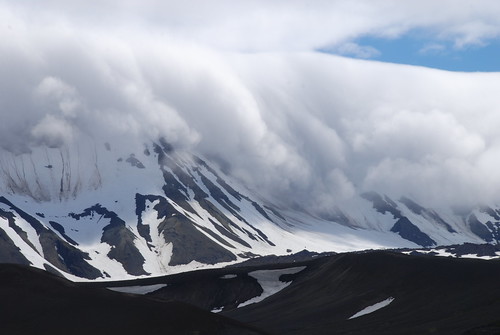
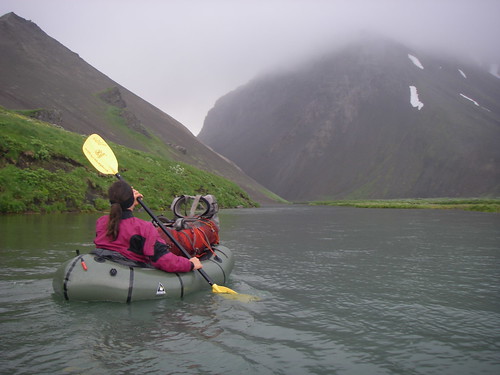
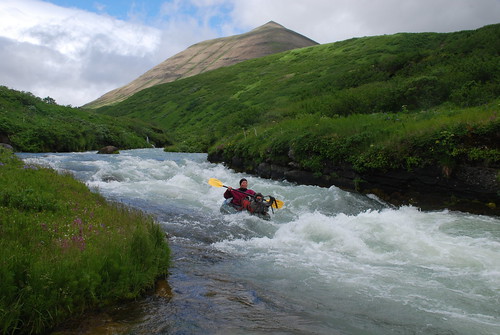
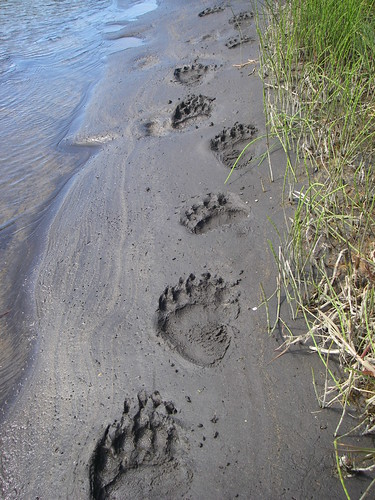
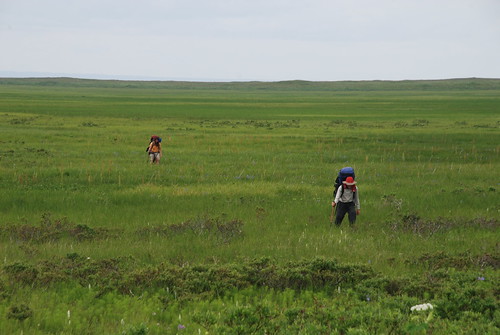
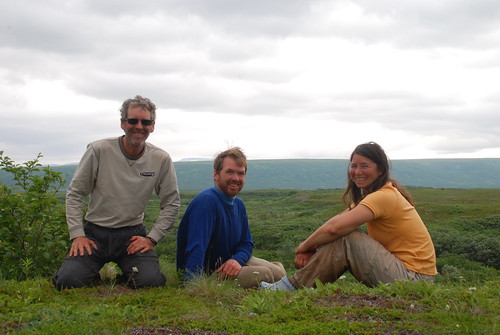

<< Home